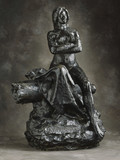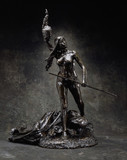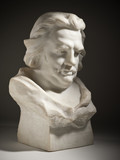The son of a cabinetmaker, Jean-Alexandre-Joseph Falguière enrolled in the École des Beaux-Arts, Toulouse, in 1844. A scholarship later awarded by the city of Toulouse enabled him to study at the École des Beaux-Arts, Paris, with the sculptor François Jouffroy (1806-1882). Falguière made his debut at the Salon in 1857 with the statuette Theseus as a Child. Two years later, in 1859, he was the joint winner with Léon Cugnot (1835-1894) of the Prix de Rome. At the Académie Française in Rome, Falguière came under the influence of fellow student Jean-Baptiste Carpeaux (1827-1875), who would become a leading sculptor of the Second Empire (1852-1870). Falguière remained in Rome until 1865 but exhibited at the Salon in Paris without interruption from 1863 to 1899.
Despite the academy’s objections over the excessive realism in his works, many of his sculptures were acquired by the French government. After his return to Paris, Falguière made a series of sculptures of female figures, identified by mythological names but conceived as modern women. He was awarded the Medal of Honor at the Salon of 1868 for his marble sculpture Tarcisius, in which he represents the Christian martyr as a slender youth. During the siege of Paris by the Prussians in 1870, Falguière served in the National Guard and modeled a celebrated statue, Resistance, in the snow. A maquette for the ephemeral sculpture is at LACMA. In 1882 Falguière was appointed professor at the École des Beaux-Arts and elected to membership at the Académie des Beaux-Arts. An extremely productive artist, he exhibited at the Exposition Universelle of 1867 and 1878, and the Exposition Centennale of 1900. He produced a number of sculpture portraits as well as sculptures for public monuments. Although sculptures are predominant in his oeuvre, Falguière also exhibited a few paintings, including The Wrestlers (Paris, Musée d’Orsay), for which LACMA’s Man Smoking a Pipe is a sketch.



